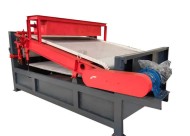Magnetic separation is an important mineral beneficiation processing technology. Here, I have listed the FAQ of magnetic separation.
You may interest in
How many types of magnetic separators?
What magnetic separators machine JXSC supply? wet type, dry type, high intensity, three-disc, etc.
Contact us for magnetic separation machine selection help, price, processing plant design.
China is one of the earliest countries to understand the magnetic phenomenon. The ancient Chinese discovered that magnets can attract iron, but can not attract gold, silver, copper and other metals. They also discovered the directivity of magnets and produced the earliest compass – Sinan.
Aurora is also formed by the action of a magnetic field.
- What is magnetic separation?
A method of mineral separation in non – uniform magnetic field based on the magnetic difference of various minerals. - What are the applications?
Ferrous metals (iron, manganese, chromium, etc.) ore separation;
Non-Ferrous Metal (tungsten, tantalum, etc.) and rare metals separation;
Non-metallic (asbestos, diamond, kaolin, etc.) ore separation;
Removal of magnetic components from solid materials and waste. - What is the magnetic separation working principle?
Under the flushing action of the water flow, the ore particles are loose.
In the magnetic field, the magnetic ore particles are magnetically aggregated to form a magnet lump, which is attracted on the cylinder. With the cylinder rotates, the non-magnetic mineral such as gangue falls off, and the magnetic lump that is finally attracted on the cylinder surface is the concentrate ore. The concentrate goes to the edge of the cylinder where has weakest magnetic strength, and is discharged into the concentrate tank under the action of the flushing water. Non-magnetic or weakly magnetic minerals are left in the slurry and finally discharged, which is the tailings. - What’s the precondition of magnetic beneficiation?
1. There must be an uneven magnetic field of sufficient strength and gradient;
2. There must be a certain magnetic difference between the minerals, that is, the specific susceptibillity of the two minerals is different.
3. For minerals with strong magnetic properties, the magnetic force they receive is greater than the sum of various mechanical forces.
The necessary condition for the separation of the magnetic ore particles is that the magnetic force of the magnetic ore particles must be greater than the combined force of the mechanical forces opposed to it. - Why is magnetic separation only in non-uniform magnetic fields?
In a uniform magnetic field, the ore is only subjected to torque, so that its long axis direction is parallel to the direction of the magnetic field.
In a non-uniform magnetic field, the ore particles are not only affected by the torque but also by the magnetic force. The ore particles are rotated and moved in the direction in which the magnetic field gradient is increased, and finally absorbed on the surface of the magnetic pole.
In this way, the magnetic particles with different magnetic properties are separated, so the magnetic separation can only be achieved in a non-uniform magnetic field. - Magnetic minerals classification
Strong magnetic minerals: It is easy to pick out in a weak magnetic separator with magnetic field strength H=900~1800Oe.
There are few such minerals, mainly magnetite, pyrrhotite, titanomagnetite, zinc-iron spar, and the like.
Weak magnetic minerals: In the magnetic field strength H = 6000 ~ 2000 Oersted, magnetic beneficiation, some difficult, and some easy.
Mainly iron-manganese ore, hematite, specularite, limonite, siderite, rhodochrosite, etc.; some titanium, chromium, tungsten containing minerals; biotite, hornblende, epidote, chlorite, olivine, garnet, pyroxene, etc.;
Non-magnetic minerals: The magnetic separation method is not available currently.
There are many such minerals, including:
Some metal minerals – chalcopyrite, galena, sphalerite, molybdenite, scheelite, cassiterite, gold, etc.;
Most non-metallic minerals – sulfur, coal, graphite, diamond, gypsum, kaolin, etc.;
Most of the rock-forming minerals – quartz, feldspar, calcite and so on. - Magnetized roasting of weak magnetic iron ore
purpose of magnetization roasting
1. Turn the weak magnetic iron mineral into a ferromagnetic iron mineral;
2. Remove gas and crystal water from ore
3. Make ore structure loose, reduce grinding cost
4. Improve mineral processing efficiency. - How to change the surface magnetism?
1. Alkali leach magnetization
The NaOH solution leaches the siderite FeCO3, form Fe(OH)2 on the surface of the ore; the leaching compound is reoxidized to γ-Fe2O3 and Fe3O4.
2. Hydrophobic
Alkali leaching dissociates the mineral surface, and the fatty acid soap forms a hydrophobic fatty acid iron film with the iron component in the iron or slurry remaining on the mineral surface, covering the surface of the mineral to increase the magnetic susceptibility.
3. Magnetic seeds
Adjust the slurry, add magnetic seeds (such as finely ground magnetite powder) and surfactant to selectively adhere the magnetic seeds to the target mineral to improve the magnetic properties of the target mineral, and then separate and recycle it with weak magnetic field magnetic separation equipment.
4. Magnetization agent
The additional magnetic species is selectively attracted on the target mineral by the magnetizing agent to increase its magnetic properties. - What are the types of magnetic separators?
Since the 1980s, with the advent of bismuth-iron-boron high magnetic rare earth permanent magnet materials, the types of magnetic separators have become increasingly diverse.
Classification of magnetic separation equipment
According to the strength of the magnetic field: weak, medium and strong.
According to media: dry type, wet type separator.
According to the magnetic field type: constant, rotating, alternating, pulsating.
According to the magnetic separator structure: cylindrical type, belt type, disc type, ring type, etc.
LATEST PRODUCTS
-
Tubular Screw Conveyor
【Capacity】6-50 m3/h 【Procesible Material】 …
-
Heavy Plate Feeder
Capacity: 100-240 m3/h Power: 15-45 kW Speed: 0…
-
Plate Magnetic Separator
【Capacity】8-35 t/h 【Power】1.5-3 kW 【Applic…










